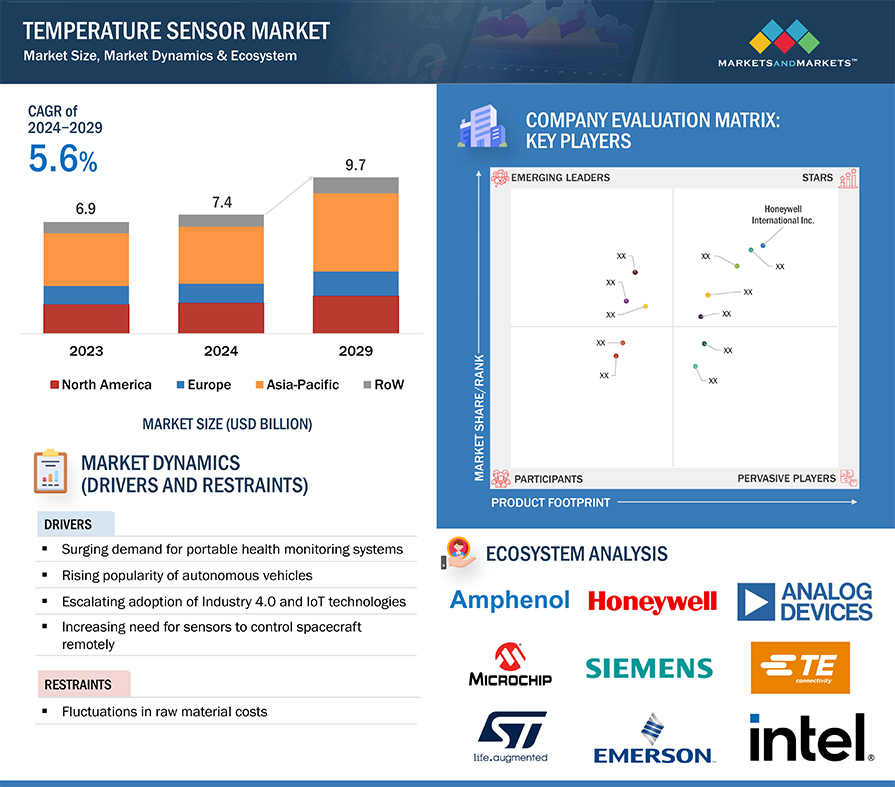The temperature sensor market is experiencing significant growth as industries increasingly rely on accurate and efficient temperature monitoring systems. This market is segmented by product type, output, connectivity, end-user industry, and region, each playing a vital role in shaping its expansion. From consumer electronics to oil and gas, temperature sensors are critical in ensuring the optimal performance and safety of various applications.
Product Type: Contact vs. Non-Contact Temperature Sensors
Temperature sensors can be broadly categorized into two types: contact and non-contact. Contact temperature sensors, such as thermocouples, resistance temperature detectors (RTDs), and thermistors, require physical contact with the object to measure its temperature. These sensors are widely used in applications where direct temperature measurement is essential, such as in consumer electronics and industrial processes.
Non-contact temperature sensors, including infrared (IR) sensors and thermal imagers, measure temperature from a distance by detecting the emitted radiation from the object. These sensors are ideal for applications where contact is not feasible, such as in hazardous environments or moving objects. The growing adoption of non-contact temperature sensors in industrial automation, automotive, and healthcare sectors is driving the market forward.
Download PDF Brochure @ https://www.marketsandmarkets.com/pdfdownloadNew.asp?id=522

Output: Analog vs. Digital Temperature Sensors
Temperature sensors are also classified based on their output, either analog or digital. Analog temperature sensors provide continuous voltage or current signals proportional to the measured temperature. These sensors are often used in applications requiring precise and linear temperature measurements, such as in HVAC systems and automotive engines.
Digital temperature sensors, on the other hand, convert the measured temperature into digital signals, which are easier to process and integrate into modern electronic systems. Digital sensors offer advantages such as higher accuracy, reduced noise, and easier interfacing with microcontrollers, making them increasingly popular in consumer electronics, smart home devices, and wearable technology.
Connectivity: Wired vs. Wireless Temperature Sensors
Connectivity is another crucial aspect of temperature sensors, with options including wired and wireless solutions. Wired temperature sensors are traditionally used in environments where stable and reliable connections are required, such as in industrial automation and manufacturing processes. These sensors offer consistent performance and are less susceptible to interference, making them suitable for critical applications.
Wireless temperature sensors, however, are gaining traction due to their flexibility, ease of installation, and ability to transmit data over long distances. They are increasingly used in smart homes, building automation, and remote monitoring applications, where wiring can be challenging or impractical. The growing demand for wireless sensors is driving innovation in low-power, long-range communication technologies, further expanding the market.
End-User Industry: From Consumer Electronics to Oil & Gas
The temperature sensor market serves a wide range of end-user industries, with consumer electronics and oil & gas being among the most prominent. In consumer electronics, temperature sensors are vital in managing device performance, preventing overheating, and enhancing user safety. The proliferation of smartphones, laptops, and wearable devices is fueling the demand for compact, accurate, and energy-efficient temperature sensors.
In the oil & gas industry, temperature sensors are critical for monitoring and controlling processes in extreme environments. They are used in drilling operations, pipeline monitoring, and refining processes, where precise temperature control is essential for safety and efficiency. The growing focus on automation and safety in the oil & gas sector is driving the adoption of advanced temperature sensors, contributing to the market’s growth.
Browse For More Details @ https://www.marketsandmarkets.com/Market-Reports/temperature-sensor-market-522.html
Regional Insights: A Global Perspective
The temperature sensor market is expanding globally, with significant growth observed in regions such as North America, Europe, Asia-Pacific, and the Middle East & Africa. North America leads the market, driven by the strong presence of key players, technological advancements, and the high adoption rate of smart devices. Europe follows closely, with a focus on industrial automation and energy efficiency.
The Asia-Pacific region is witnessing rapid growth due to the booming electronics industry, increasing industrialization, and rising demand for smart home devices. The Middle East & Africa region is also seeing growth, particularly in the oil & gas industry, where temperature sensors are essential for process control and safety.
Global Market Forecast: Future Trends and Opportunities
The global temperature sensor market is poised for substantial growth in the coming years, driven by technological advancements, increasing demand for automation, and the rising adoption of smart devices. As industries continue to prioritize efficiency, safety, and connectivity, the market is expected to expand, creating new opportunities for manufacturers and suppliers.
